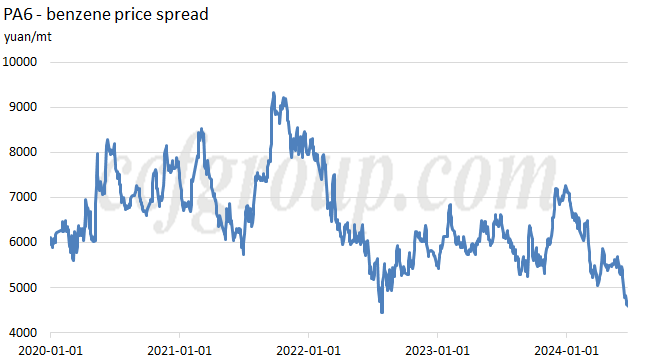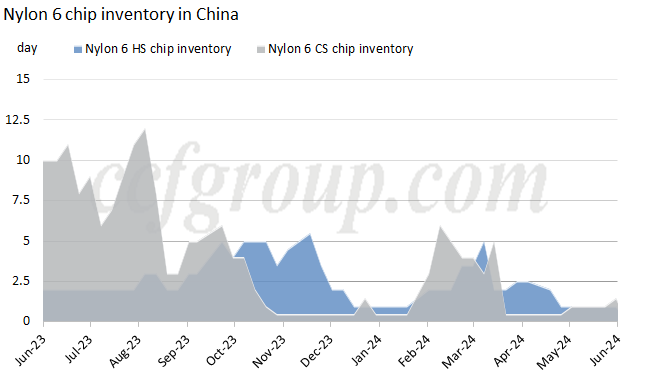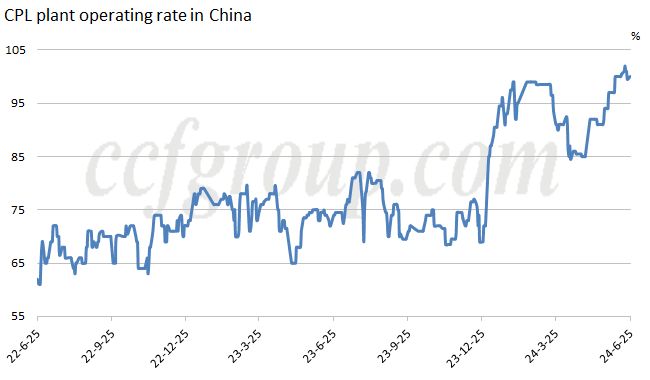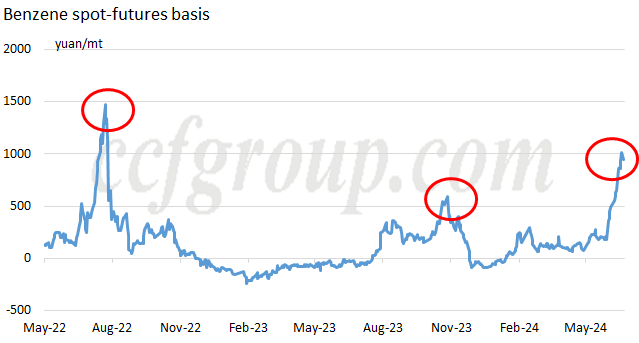CPL & PA6: current risks mainly from benzene
CPL & PA6 profit margin in historical low

The sum of processing fees for CPL and PA6 (also known as PA6-benzene) has currently reached its historical lowest level, around 4,600-4,700yuan/mt. This indicates that there is hardly any more room for compression in processing fees along the industry chain.
CPL & PA6 operating rate at super high levels
Currently, both CPL and chip are maintaining extremely high operating rates. There have been some equipment maintenance and production plans recently, but overall, these two segments are more or less stable.
| CPL plant | Capacity (kt/year) | Note |
| Lunan Chemical | 400 | Plans to shut for 15-20 days since end-Jun |
| Luxi Chemical | 300 | Plans to start up in end-Jun |
| PA6 plant | Capacity (kt/year) | Note |
| Qizheng New Material | 50 | Started up in June 2024 |
| Luxi Chemical | 100 | Started up two lines in early Jun and late June respectively |
There has been a slight reflection in chip inventory recently, but it has remained at a relatively low level. Although the demand for July is expected to weaken compared to the previous month, the decrease is not significant, and downstream buyers are stocking up on chips at a very low rate. Therefore, even if there is accumulation in July and August, it is likely to be gradual and slow.


Starting from June 6, the operating rate of CPL factories has reached 100%, and in the latter half of June, it even exceeded 100% at times. With all CPL factories operating normally at full capacity, the CPL operating rate will remain at 100% or higher.
How did the operating rate exceed 100%?
In principle, CCFGroup's capacity assessment is based on the factory's official website or publicly disclosed numbers, most of which represent the design capacity. However, most factories can actually produce beyond the design capacity. After the commissioning of new units, continuous technological improvements and optimizations can push the actual operating rate to 120% of the design capacity or even higher. When calculating the average operating rate, CCFGroup uses the actual capacity/design capacity to estimate the operating rate to reflect a relatively realistic supply level.
For example: If a factory has a design capacity of 300kt/year and an actual capacity of nearly 350kt/year, then in the detailed calculation, the operating rate would be 350/300=117%.
Due to the prevalence of such scenarios at present, the average operating rate of CPL may exceed 100%, even in cases where some units are unable to restart (like Kingho).
Based on the current CPL operation, if Dongming Risun and Lubao ramp up production successively, by the end of June, Luxi is expected to start a new 300kt/year unit, and Lubao will formally eliminate bottlenecks, increasing capacity from 100kt/year to 150kt/year. CPL is poised to move towards oversupply.
Biggest price driving factor in benzene
From the perspective of absolute prices, the fluctuations in the industry chain are mainly dependent on benzene.

However, benzene is currently facing significant downside risks. The chart shows the price spread between benzene spot and mainstream futures contract. Over the past two years, benzene prices have seen substantial fluctuations. Generally, when the spread reaches above 500yuan/mt in a given month, spot prices have declined significantly.
For CPL, although supply and demand are roughly balanced at present, there is a slightly larger spot volume in 2024, with buyers having relatively more influence, which weakens the balance. If benzene prices fall, CPL is unlikely to resist the pressure.
Therefore, it is expected that in the short term, there is a high probability of a general decrease in nylon industry chain prices. The extent of the downward movement at each stage will depend on how much benzene declines during this process.
- Top keywords
- Cotton Price
- Cotton Futures Price
- Cotton Futures
- CZCE
- PTA Futures Price
- Chemical Fiber
- Polyester Prices
- Wool price
- PTA Futures
- Shengze Silk
- China
- Yarn Price
- price
- China Textile City
- Fibre Price
- Benzene Price
- Cotton
- Index
- Cotton Index
- PTA
- fabric price
- NYMEX
- Top 10
- textile industry
- Spot Cotton
- Cotton Yarn
- Polyester Price
- Futures
- PTA Price
- cotton yarn price

